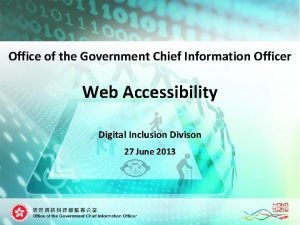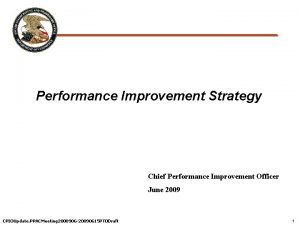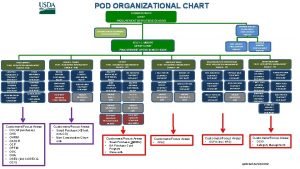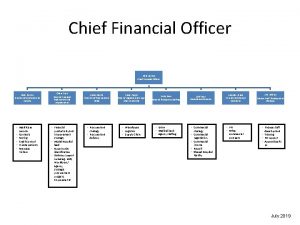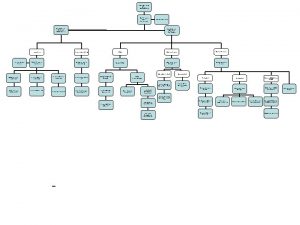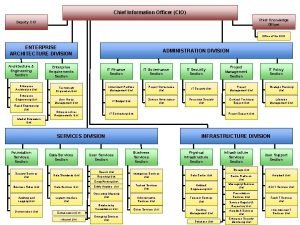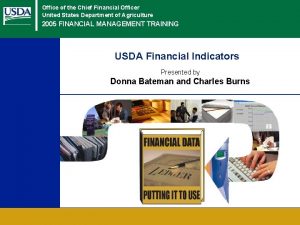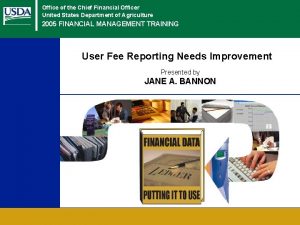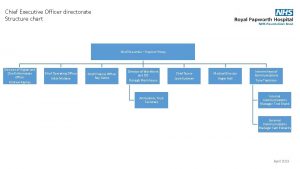USDA OFFICE OF THE CHIEF FINANCIAL OFFICER FINANCIAL
















- Slides: 16

USDA OFFICE OF THE CHIEF FINANCIAL OFFICER FINANCIAL MANAGEMENT TRAINING 1

CAP Goal 9 “Getting Payments Right” • Financial Management Training July 2019 • Presenter: Gloria Perry • (Office of Management and Budget)

CAP Goal 9 “Getting Payments Right”? What is it? • Cross-Agency Priority (CAP) Goals are a tool used by leadership to accelerate progress on a limited number of Presidential priority areas where implementation requires active collaboration among multiple agencies. • As a subset of Presidential priorities, CAP Goals are used to implement the President’s Management Agenda. What are we trying to accomplish through CAP Goal 9? • • Demonstrate stewardship of taxpayer dollars by reducing monetary loss and making payments correctly the first time. Where can I find more information? • The web address can be found here: https: //www. performance. gov/CAP/getting-payments-right/

Questions?

Payment Integrity Financial Management Training July 2019 Presenter: Iris Roseboro (Office of the Chief Financial Officer)

What is Payment Integrity? The Payment Integrity initiative (a. k. a. improper payments initiative) began with the passage of the Improper Payments Information Act of 2002, as amended. The Office of Management and Budget (OMB) released guidance on implementing the improper payment legislation through OMB Circular A-123, Appendix C. The reporting structure of improper payments is found in OMB Circular A -136.

What is an Improper Payment? • To clarify a proper payment has four main attributes: Ø right recipient Ø right amount Ø right reason Ø right time • An improper payment is any payment that should not have been made or that was made in an incorrect amount under statutory, contractual, administrative, or other legally applicable requirements.

What is an Improper Payment? Cont. . • Occur when either: • • Federal funds go to the wrong recipient • Documentation is not available during review to discern that a payment was proper • Recipient uses Federal funds for an improper purpose Recipient receives the incorrect amount of funds (either an underpayment or overpayment)

OMB’s Matrix of Improper Payment Categories • USDA reports improper payments utilizing the root cause categories listed in the chart below. These root causes for improper payments are reported in the Agency Financial Report and on www. paymentaccuracy. gov

Root Causes of Error • General rule of thumb when attempting to identify the root cause of error. . • Ask yourself. If this issue was resolved, would this improper payment still occur? • Sometimes, there are multiple root causes of error within a single payment which means several issues may need to be addressed in order to prevent the improper payment from occurring again • It is important to properly identify the root cause of the improper payment to ensure the corrective actions can be effective.

Root Causes of Error How would someone identify the root cause of error in an improper payment? Let’s create an example of an improper payment to find out. • • Farmer Jon gets subsidized by USDA to raise pigs. Each pig provides the farmer $100 in subsidy payment. The farmer owns cows, sheep, pigs, and horses. In this example, the farmer owns 5 pigs. However, it was 4 am in the morning (pre-coffee), so he reported to USDA that he owned 6 pigs. What is the root cause of error?

Another Example for Determining Root Cause of Error • Lisa filed all the necessary paperwork and got approved for a USDA loan, which has an adjusted gross income (AGI) qualification. • It was discovered during a post-review of the loan that one of the deductions was claimed twice. • Rectifying the extra deduction caused her AGI to increase above the maximum threshold to be considered eligible for the USDA loan. What is the root cause of error?

USDA’s Sub Root Causes Beginning 2019, agencies with programs susceptible to significant improper payments are asked: 1. to categorize improper payments into “sub root causes” that further define root causes of error; and 2. to categorizing according to the root causes in the OMB. Ultimate goal: Help USDA obtain a clearer understanding of what truly caused the improper payments to occur.

Breakdown of USDA’s Improper Payments • USDA FY 2018 Total Improper Payments per OMB root causes category ($in millions)

Corrective Action • Know what caused the improper payment to occur and establish a plan to prevent it from happening again. • Analyze available numbers in effort to affect a different outcome in the future. • Breakdown improper payments by cause. (There should be a clear correlation between the root cause of the improper payment and the suggested corrective action to implement it. ) • Corrective actions should be cost-effective and not prevent program access for eligible participants.

Questions?
 Usda office of the chief financial officer
Usda office of the chief financial officer Office of the government chief information officer
Office of the government chief information officer Company structure ceo cfo coo
Company structure ceo cfo coo Chapter 9 lesson 3 commander in chief and chief diplomat
Chapter 9 lesson 3 commander in chief and chief diplomat Chief knowledge officer job description
Chief knowledge officer job description Chief data officer training
Chief data officer training Chief improvement officer
Chief improvement officer Adolfo gonzales chief probation officer
Adolfo gonzales chief probation officer Alexander kjerulf happiness at work
Alexander kjerulf happiness at work Chief reality officer
Chief reality officer Ccccio
Ccccio Capitalize chief executive officer
Capitalize chief executive officer Chief accountability officer
Chief accountability officer Chief contracting officer
Chief contracting officer Chief csr officer
Chief csr officer Chief procurement officer organization chart
Chief procurement officer organization chart Jp9102
Jp9102

